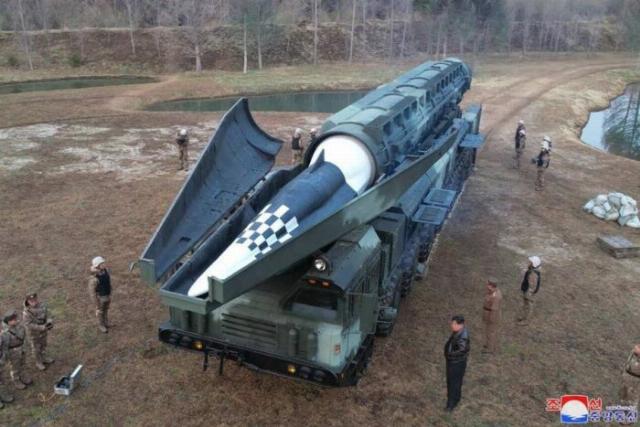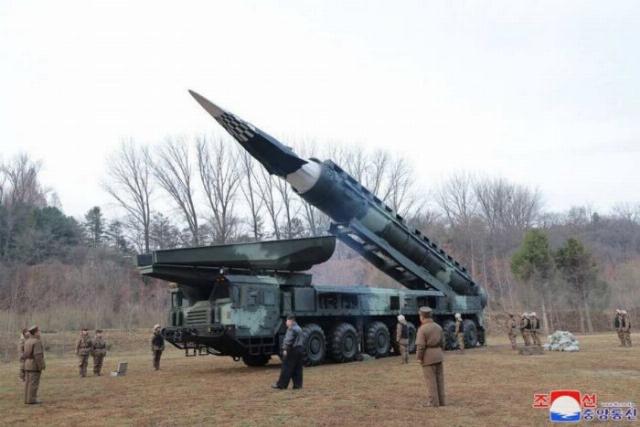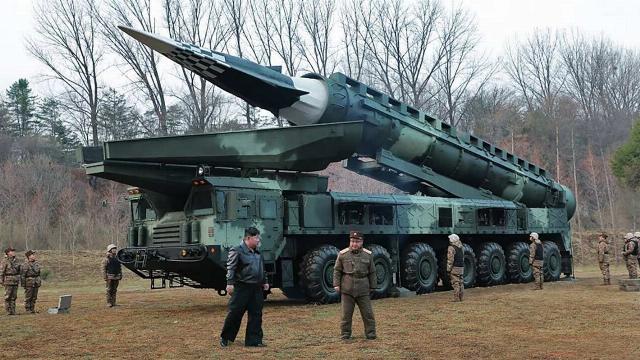Western media reports on the publication by North Korea of photographs and videos demonstrating a new medium-range hypersonic missile system, which uses a solid-fuel rocket accelerator and a wedge-shaped hypersonic overclocking glider in the head (GCH).
The tested missile, called Hwasongpho-16Bi (Hwasongpho-16B), launched from a 14-wheeled transport launcher (TPU), the design of which is equipped with a folding section in the GCH that protects the overclocking glider in the stowed position.

Folding section in the head part of the TPU
North Korean authorities released images and videos of the Hwasongfo-16Bi missile (also called Hwasong-16B/Hwasong-16B) along with an official release the day after the launch, which took place on April 2, 20224. The event was attended by the country's leader Kim Jong-un and other senior officials.
An official statement from North Korea says that the device "reached its first peak at an altitude of 101.1 km, and the second [at an altitude of] 72.3 km, making a [flight] of 1000 km, as planned, and accurately hit the waters of the East Korean Sea [aka the Sea of Japan]."
For their part, the South Korean authorities said that, according to their estimates, the total distance traveled by the missile is about 600 km. They also stated that it is a ballistic missile with a maximum firing range of 3,000 to 5,500 km. But they added that "the North Koreans were probably experimenting with new warhead technologies."

Pre-launch deployment of Hwasongfo-16Bi
Since hypersonic overclocking gliders do not have an engine, rocket boosters are used to bring them to the desired altitude and accelerate them to the required speed. After launch, the overclocking glider moves towards its target along a relatively low flight path in the atmosphere at hypersonic speeds, usually determined just above MACH 5. The device is designed to have a significant degree of maneuverability, which allows it to randomly change course on the route, as well as gain altitude or descend. Combined with their high speed, this creates serious problems for the PRO defenders.
A North Korean press release claims that the test of the Hwasongfo-16Bi hypersonic missile system demonstrated the ability of the upper stage to perform glide-jump maneuvers and quickly change direction. Also known as the porpoise trajectory, gliding usually involves at least one maneuver, creating one or more "steps" down as the head unit (GCH) heads towards its target. This ability is also possessed to varying degrees by more traditional ballistic missiles with detachable maneuverable warheads (type MaRV).
The Hwasongfo-16Bi is also described as having "military-strategic importance" – a formulation that North Korean authorities have previously used to describe systems capable of carrying nuclear weapons. However, there is no specific mention of what type of warhead (warhead) can be installed inside the upper stage. It can potentially be considered as a dual-use system using conventional and nuclear warheads. Western analysts believe that a nuclear warhead is likely to become a priority for the North Korean system.
The North Korean press release also reports that the Hwasongfo-16B has a two-stage upper stage. From the photos that Pyongyang published, it is unclear how many individual rocket engines may be contained in the first stage.
Western experts note that for several years North Korea has been investing heavily in solid-fuel rocket engines for an increasingly diverse arsenal of ballistic missiles. Compared to liquid-fueled rocket types, solid-fuel rockets are safer to handle and easier to maintain. The volatile and corrosive properties of liquid propellant usually mean that rockets using it cannot remain fueled for a long period of time. Rockets using solid-fuel rocket engines, which do not require refueling before launch, are much more affordable and flexible weapons.
Launch of the Hwasongfo-16Bi hypersonic missile system
With this in mind, it is noted that earlier North Korea tested another design of a ballistic missile with a hypersonic overclocking glider in the GCH, called "Hwasong-8" (Hwasong-8). However, this design used a liquid-fueled launch vehicle. Based on the statement about the Hwasong-16B, it is assumed that North Korea is seeking to completely abandon liquid-fuel ballistic missiles and hypersonic weapons based on them.
As in the earlier case of the Hwasong-8, with regard to the Hwasongfo-16B hypersonic missile system, it is noted that it has a number of common visual similarities with the Chinese road-mobile DF-17 in both design and TPU, although the designs are clearly different. In the past, foreign experts believed that the Russian Avangard mine-based hypersonic missile system, also equipped with an overclocking gliding unit, may also have, in general, a similar configuration.
Open sources in both the West and South Korea are trying to understand to what extent China or Russia have contributed to Pyongyang's progress in the hypersonic field. At the same time, it is noted that the current US developments on an air, sea or land-based hypersonic medium-range missile have not yet led to satisfactory results.
It is obvious that North Korea continues to move forward in the development of new ballistic and hypersonic missile systems, as well as working on other advanced weapons, which now include the Hwasongfo-16B.
Based on the materials of the resource www.twz.com

